Introduced in 2013 by Pega, PRPC is known as the PegaRULES Process Commander, which acts as the core component in BPM solutions. PRPC is a Java-based tool that helps streamline and optimise processes, mainly built to optimise ad-hoc tasks. PRPC has two core components: the PegaRULES database and Business Rules Engine (BRE).
Through this blog, we intend to show you light on – what is Pega PRPC, its capabilities, business rules, the Business rule engine and its significance, Pega PRPC and Six Sigma, and a lot more in detail. Let’s discuss now:
Pega PRPC - Table of Contents
| Table of Content-Pega PRPC |
|
➤ What are Business Rules in PRPC? ➤ What are the components of BRE? |
What is Pega?
Pega is well-known for its low-code process automation software platform and is one of its leading providers. The highlight of Pega is that it is – ‘built for change’. It means that the automation software can update business processes in tune with the changes in the situation. This is why Pega is pointed out as one of the leaders in process automation.
Pega supports building software applications quickly and offers a successful end-to-end customer experience. Moreover, it provides the best solutions for case management, content management, and security of resources for all types of businesses.
What is Pega PRPC?
Know that Pega PRPC is the software framework, and Pega PRPC is a BPM suite that provides comprehensive solutions to optimise business processes. In technical terms, Pega PRPC is equipped with industry-interfacing standards and supports declarative rules and multi-threaded execution.
To interchange data, Pega PRPC can effectively integrate with other systems such as databases, email servers, Enterprise Information Systems (EIS), etc. While integrating, Pega PRPC functions as the server as well as the client to support both front-end and back-end applications. Additionally, Pega PRPC can integrate with applications and standards such as HTML, SOAP, .NET, BPEL, JCA, JMS, JSR168, and JSR 94. Here, the integration is usually carried out through connectors
Why Pega PRPC?
Pega PRPC is built to adapt to the rapid changes in business processes dynamically. Generally, Pega PRPC avoids coding to speed up business processes through its automation capabilities. For that, it streamlines all the processes into a single platform for automation. And it carries out the documentation part along with process execution simultaneously.
Pega PRPC is the best framework for performing on-board rule management and advanced event correlation. It looks over business processes keenly and responds quickly when there are performance issues such as delays in processing, submitting work objects, refreshing screens, etc. When these issues emerge, Pega PRPC identifies and resolves them quickly.
This dynamic attitude of Pega PRPC in tackling issues and making changes is considered a crucial feature of Pega PRPC. Additionally, it identifies excessive use of resources in applications and when it finds anything as such, then optimises them immediately. All these factors ensure the drastic improvement in business processes. Overall, Pega PRPC supports the continuous improvement of processes over time.
| Looking forward to a career as a Pega Certified professional? Check out the "Pega Training" and get certified today |
What are Business Rules in PRPC?
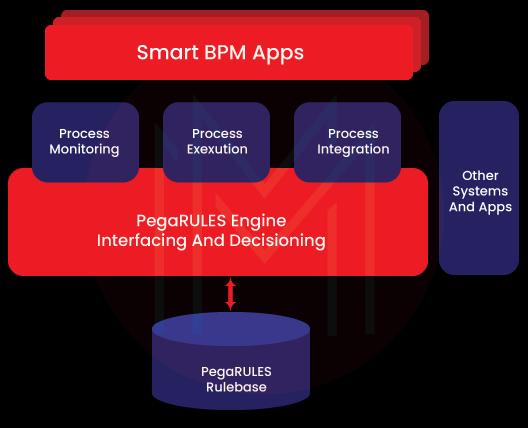
In general, business rules are the brain of a business, which includes an organisation’s processes, procedures, and practices. In addition, business policies, constraints, and reasoning capabilities can be part of business rules. More or less, business rules include all the knowledge of an organisation. In other words, business rules reflect the goals of a business in the form of constraints and decisions. Mainly, business rules support eliminating inefficiencies in business processes.
Realise that setting business rules, in a way, is crucial for businesses because it decides the outcome of a business predominantly. Another essential component related to business rules is ‘business logic’, which is nothing but a sequence of operations designed based on business rules. They support integrating, monitoring, and executing business processes, and extract the best results.
What is Business Rule Engine (BRE)?
BRE is the core Java-based rule engine. This event-driven tool carries out declarative ‘on-change’ processing successfully. BRE is the place where business rules are stored and updated according to the changing business needs and regulations. Note that business rules are stored in a non-procedural and non-programming form. BRE offers good flexibility so that even a non-programmer can modify a business logic in the BPM system. Moreover, BRE transfers data between systems irrespective of its content type, such as parsed, interpreted, or extracted.
In general, BRE executes business rules separately from executing other processes in an application. As said earlier, this setup allows business users to alter the business rules according to their needs, and at the same time, without affecting the other processes in the system. If any conflict is found while modifying business rules by users, BRE enables an alert flag to warn the users to resolve the same. Note that BRE can be embedded and called from other systems using JSR94 rules.
Considering the above factors, you can realise that BRE streamlines business operations based on business rules when there is a need to simplify complex business processes. As a result, business agility is improved, and costs are reduced significantly. Here, the processes may have many tasks, sub-tasks, and decisions. Also, there may be a requirement for large-scale task allocation inside the organisation and going beyond the organisation. At these times, BRE plays a significant role and simplifies everything.
What are the Components of BRE?
Let’s go through the components of BRE as follows:
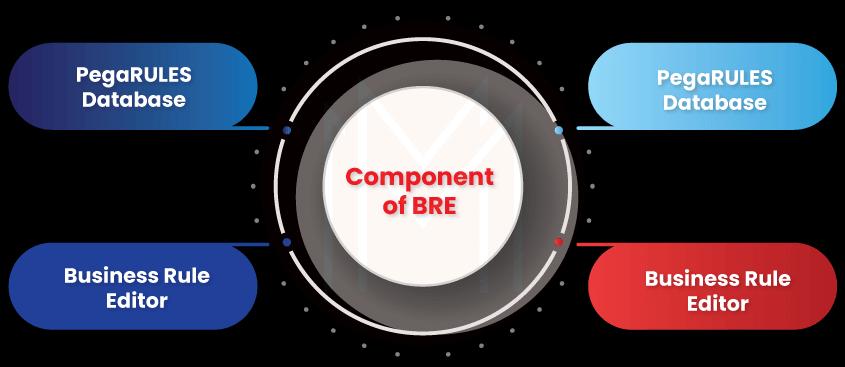
PegaRULES Database:
In this database, all the business rules, system information, and related transactions are stored. The following image shows the mapping of database tables to the PegaRULES database.
Business Rule Editor:
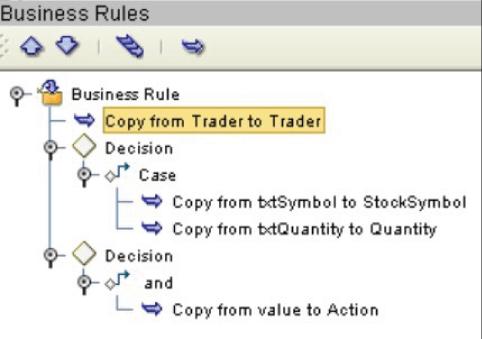
It acts as the user interface for defining, editing, and documenting business rules by users. Using the business rule editor, you can delete both rules and a set of rules, change the order of rules, and reset the destination of a rule. You can view the structure of rules and how the rules will be processed through a business rule editor.
Reporting Component:
An interface allows users to query and report the existing business rules
Rule Engine Execution Core:
It is the programming code that enforces the business rules.
What are the Key Capabilities of PRPC?
The capabilities of Pega PRPC are broad, and they cater to the requirements of BPM solutions dynamically. Let’s see them one by one:
Holistic Modelling and Automation:
Pega PRPC allows you to make holistic modelling, including properties, process flows, methods, decision rules, expressions, service levels, user interfaces, and event rules of business processes.
Business Logic Types:
Pega PRPC provides various logic types such as expressions, triggers and on-change, service level agreements, decision rules, and constraints and conditions.
Real-time Monitoring and Response:
Pega PRPC continuously tracks process KPIs and takes response actions whenever there is a deviation in business processes and procedures
Inter-operability with External Tools:
Pega PRPC performs data export through Microsoft Excel. Other applications can access data through SQL and JDBC connectors. Also, it carries out data analysis using Microsoft Excel and statistical tools like Minitab.
Ease of Specialisation:
If you integrate the Six Sigma method with Pega PRPC, the existing processes and rules will be easily modified based on the analysis results of Six Sigma.
Ability to Run on Versatile Platforms:
Pega PRPC can run on operating systems such as Windows, AIX, and Solaris, and run on application servers such as IBM WebSphere, Apache Tomcat, and BEA WebLogic. Also, the business rules can run on relational databases such as Microsoft SQL, Oracle, and IBM DB2.
Support for Complex Processes:
Pega PRPC consists of numerous worklists and process and reporting functions, which support increasing efficiency. Using service level agreements, users can manage activities and prioritise work.
Life Cycle Management of PRPC:
PRPC achieves process management and automation through six functional steps: receiving, routing, reporting, researching, responding and resolving.
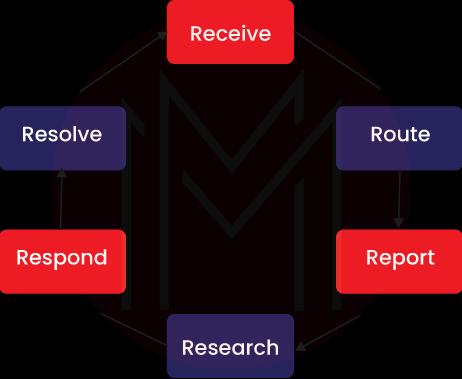
Receiving: PRPC accepts data from multiple sources for performing tasks such as modifying or updating processes.
Routing: It is about making intelligent matches and assignments based on the requirement of tasks
Reporting: It provides real-time visibility of tasks in progress, tasks completed, and details of productivity and quality
Researching: It includes the process of making analysis and decision-making by connecting with the external resources through connectors
Responding: It includes communicating status to external systems, requesting information, etc.
Resolving: Completing the tasks successfully and reporting to downstream systems automatically.
Pega PRPC and Six Sigma:
Six Sigma is the methodology that identifies key processes in a business and improves the process performance until reaching the quality goals. The most crucial aspect of implementing Six Sigma is that it encourages continuous improvement in business processes.
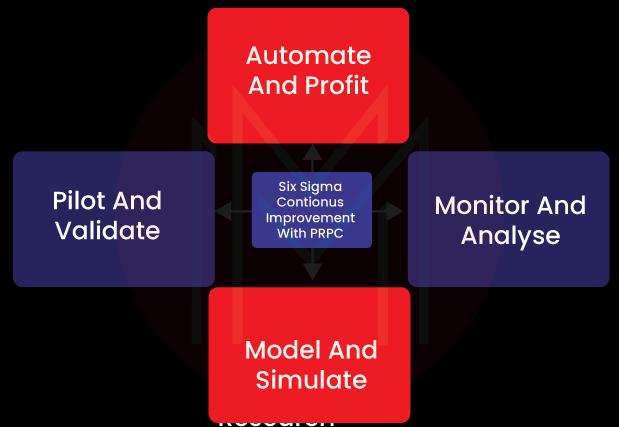
If you integrate Pega PRPC with Six Sigma techniques, it dynamically optimises business processes based on the changes in situations. This integrated approach is best for ad-hoc works in which processes need to be modified in real-time. In addition, it improves process monitoring, situation selection, event correlation, specialisation, and rule definition and execution.
| Preparing for Pega Interview? Check out the top Pega Interview Question and Answers |
Pega PRPC and Visio:
Visio is the graphical tool that functions as the front-end of Pega PRPC. And it communicates with the PegaRULEBase to define, edit, and save processes. Know that Visio helps to draw business process diagrams quickly. Visio diagrams are the live diagrams that allow business users to view the flow of automated processes in real-time. The users could modify the processes if they need, and see the changes in the process flow. This system facilitates quick adaptation to changing business needs and accelerates business processes.
Advantages of Pega PRPC:
- With its multi-dimensional hierarchical feature, Pega PRPC optimises processes, decision rules, expressions, and service levels to their maximum
- It is faster, cost-effective, and increases the ROI of businesses
- Supports migrating all the disparate, complex, and diverse business rules into a single place
- Uses service connectors such as SOAP, MQ, and active file listening to connect with other external applications
- Quickly adapts to business changes, reduces errors and mismatches, and reduces data redundancy
- Simplifies complex business activities and increases the security of resources
Essential Skills Required to Become a PRPC Developer:
As discussed earlier, Pega PRPC is the framework that helps resolve BPM solutions issues. Those who excel in Pega PRPC can automate processes and support to meet the business goals. To become a skilled Pega PRPC Developer, you should have the following skills:
- You must be expertise in Pega PRPC 5.x/6.x/7.x
- Good knowledge in J2EE,Java,C++,JSP,EJB,XML,and HTML
- Familiar with AngularJS, Java, and JQuery
- Proficiency in Agile methodologies
Conclusion
We hope that this blog might have eventually given you valuable insights about Pega PRPC on a larger scale. Keep in mind that you will be able to modify the business processes in tune with the dynamic changes in the situation by leveraging Pega PRPC in BPM solutions. We are confident that you have understood the distinguishing features of Pega PRPC that support optimising business processes. While moving on to the endnote, we can say that Pega PRPC optimises business processes through a rule-based engine and drives business growth to sky-high levels.
 On-Job Support Service
On-Job Support Service
Online Work Support for your on-job roles.

Our work-support plans provide precise options as per your project tasks. Whether you are a newbie or an experienced professional seeking assistance in completing project tasks, we are here with the following plans to meet your custom needs:
- Pay Per Hour
- Pay Per Week
- Monthly
| Name | Dates | |
|---|---|---|
| Pega Training | Jan 06 to Jan 21 | View Details |
| Pega Training | Jan 10 to Jan 25 | View Details |
| Pega Training | Jan 13 to Jan 28 | View Details |
| Pega Training | Jan 17 to Feb 01 | View Details |














